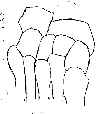- See:
- Cuboid Fracture
- Jones Fracture
- Lisfranc's Fracture
- Midtarsal Injuries
- Navicular
- Stress Fractures of the Forefoot and Midfoot
- Transverse Tarsal Joint
- Discussion:
- fifth metatarsal fracture patterns;
- Avulsion frx of base of 5th metatarsal from pull of peroneus brevis;
- Jones frx
- transverse fracture thru base of 5th metatarsal, about 1-2 cm from tip;
- this is insertion point of peroneus tertius;
- Dancer's Fracture:
- spiral frx of 5th metatarsal neck which is common in ballet dancers;
- mechanism: inversion injury resulting from mis-steps & falls off the dem pointe position;
- perineal weakness and simple fatigue may be contributory factors;
- frx is frequently displaced, and occassionally midly comminuted;
- radiographs: take care to order AP, lateral and oblique views since often one view shows significantly more displacement than the others;
- mildly displaced frx: heal w/ 6 to 8 weeks w/ short leg cast;
- displaced frxs (3-5 mm) may require ORIF;
- often these fractrues will have a long oblique fracture pattern which makes them ammenable to fixation, w/either 2.7 mm lag screws or a 2.7 mm antigluide plate;
- in cases where the long oblique frx spike lies dorsally are particullary ammenable to ORIF w/ antigluide plate;
- ref: Fractures of the distal shaft of the fifth metatarsal. "Dancer's fracture".
 - Anatomy of the Midfoot:
- Anatomy of the Midfoot:
- volar aspect of the second metatarsal is heavily reenforced by ligaments as compared to the dorsal aspect of the metatarsal base;
- this mortise configuration effectively locks the entire tarsometarsal complex, preventing medial or lateral translation;
- no significant dislocation of the metatarsals or cuneiforms can occur unless this bone is disrupted;
- for this reason, pure transmetatarsaltarsal dislocations rarely occur, & rather involve frxs thru or around the second metatarsal base
Fractures associated with neuropathic arthropathy in adults who have juvenile-onset diabetes.
Diagnostic dilemmas in foot and ankle injuries.
Pain in the foot. 2. Causes of pain in the hindfoot, midfoot, and forefoot.
Pain in the foot. 1. Evaluation of foot pain and identification of associated problems.
The stubbed great toe: a cause of occult compound fracture and infection.

